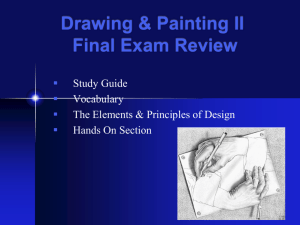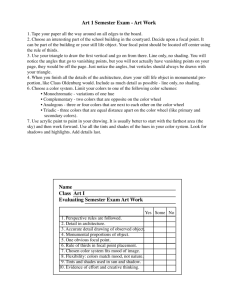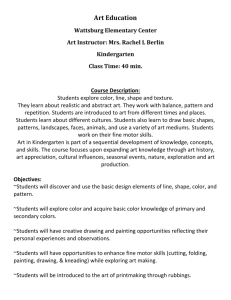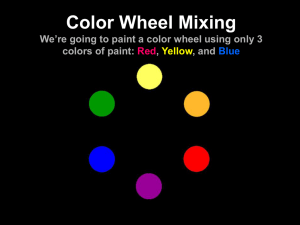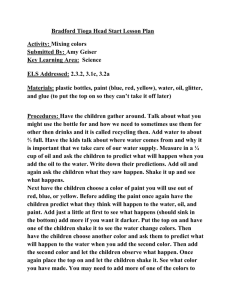dowload here.
advertisement
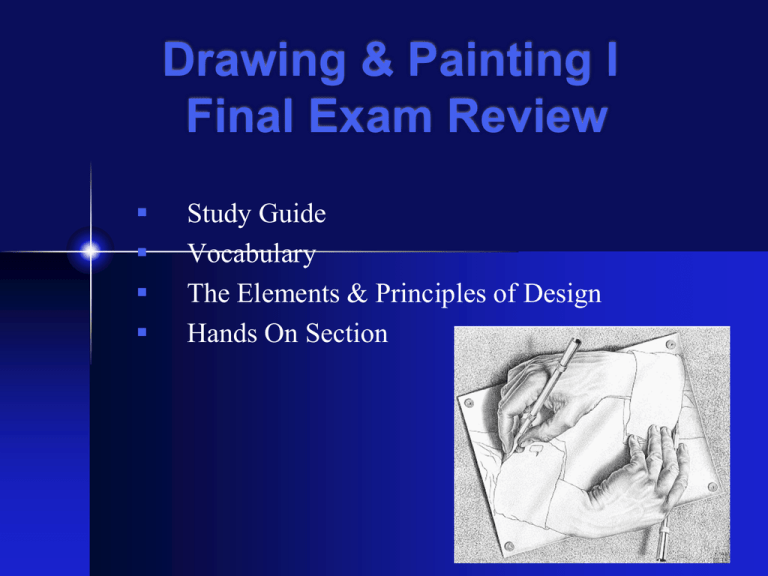
Drawing & Painting I Final Exam Review Study Guide Vocabulary The Elements & Principles of Design Hands On Section The Color Wheel Primary, Secondary, Intermediate or Tertiary Colors Basic Color Schemes Compliments opposite colors Y/V R/G B/O • Triads form a triangle R/Y/B G/O /V • Analogous 3 - 5 colors next to each other on the Color Wheel • Warm & Cool colors • Split Compliments opposite colors Y/RV/BV • Monochromatic tints & shades of one color • Tints: when white is added to a color • Shades are when black is added to a color. • Neutrals are grays Tools • Pencils (HB is the lightest, 4B medium, 6B dark) • Stump: blending tool • Burnishing: layering white colored pencil on top of other colors. • Acrylic brushes (man made) • Palette: used to mix paint on • To create a shadow add the complementary color. Water Color Techniques Water color techniques include: • dry brush • splatter • graded wash • resist Objects in the foreground of a painting are darker than in the background. Mechanical gauge paper, smudge and make hard lines. Ebony is a very dark pencil. Shading stipple blending crosshatching Caring for Brushes • Warm water (not hot) • Rub bristles in the palm of your hand • Dry and store bristles up A palette is used to mix colors on. A Color Wheel is the tool to select colors from. Vocabulary • Focal point: center of interest • Color Wheel: a circular tool used to select color schemes from. • Acrylic Paint: (plastic resin based) • Cold Press Watercolor paper: rough, most forgiving • Hot Press Watercolor paper: smooth • Hue: color • Wash: a large area of thinly spread paint • Wet on Wet: paint dripped into wet paint Vocabulary • Horizon line: Where the land and sky meet • Vanishing Point: Where all parallel lines come together. • Perspective: The illusion of creating a 3D drawing on a 2D flat surface. • Blind Contour: not lifting pencil as you draw. • A focal point should always be off center. • Composition: organization of a drawing • Negative Space: the background or empty area • Positive Space: the filled space in a drawing or painting. • Value: the gradations in shading. • Gesture: quick loose drawing. • Critique: defend, see possibilities • Quality of Art: craftsmanship, creativity, purpose Elements & Principles of Design… • • • • • • • Color Form (3D) Line Shape (2D)geometric/organic Space Texture Value (Shading) • • • • • • • Balance Contrast Emphasis Movement Pattern Rhythm Unity Value Shape; 2D Geometric, Organic Form Negative and Positive Space Lines can show personality or expression. Contrast, Emphasis Texture Balance • Asymmetrical • Symmetrical Unity Abstract One Point Perspective Stippling Movement Pattern Rhythm Line, Color, Pattern, Hands On! Finish you current project...


